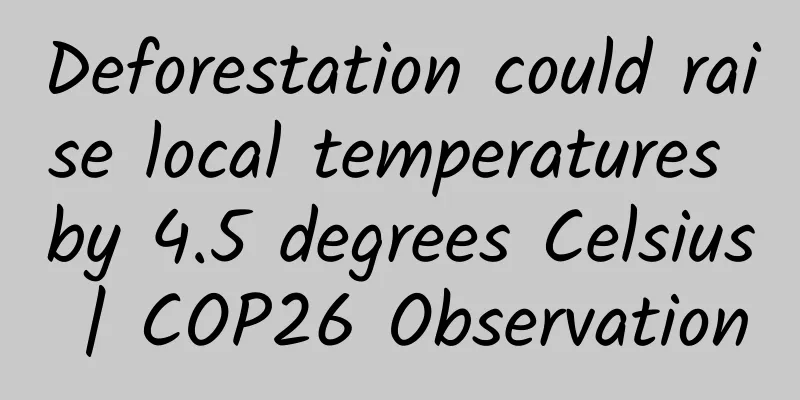Deforestation could raise local temperatures by 4.5 degrees Celsius | COP26 Observation

|
Forests directly cool the planet and absorb carbon dioxide from the atmosphere. So what happens when forests are cut down? In tropical countries such as Indonesia, Brazil and Congo, rapid deforestation may account for up to 75% of the surface warming observed between 1950 and 2010. New research from The Conversation takes a closer look at this phenomenon. Using satellite data from Indonesia, Malaysia and Papua New Guinea, we found that deforestation can increase local temperatures by up to 4.5 degrees Celsius, even increasing temperatures in undisturbed forests up to 6 kilometers away. More than 40 percent of the world’s population lives in the tropics, where rising heat and humidity could push them into deadly conditions under climate change. As the planet warms, keeping forests intact is critical to protecting the people who live in and around them. At the recent Climate Change Summit in Glasgow, world leaders representing 85% of the Earth’s remaining forests pledged to end and reverse deforestation by 2030. This is a critical step in our efforts to stop the planet warming beyond the internationally agreed limit of 1.5 degrees Celsius, because forests store vast amounts of carbon. Deforestation releases this carbon – around 5.2 billion tonnes of CO2 per year – back into the atmosphere. This represents nearly 10% of global emissions from 2009-2016. Deforestation is particularly widespread in Southeast Asia. We calculated that between 2000 and 2019, Indonesia lost 17% of its forest area (26.8 million hectares of land) and Malaysia lost 28% (8.12 million hectares). Other parts of the region, such as Papua New Guinea, are considered “deforestation hotspots” because they are at high risk of losing forest cover over the next decade. "Forests in the region have been cleared for a variety of reasons, including expansion of palm oil and timber plantations, logging, mining and small farm construction. These new land use types produce distinct spatial patterns of forest loss, which we can observe and measure using satellites." Related research We already knew that forests can directly cool the climate and that losing forests can cause local temperatures to rise. But we wanted to understand whether different patterns of forest loss affect the magnitude of temperature increases, and the extent to which warming spreads from deforested sites to adjacent, unaltered areas. To find out, the researchers used satellite images that measure land surface temperatures. As shown in the figure below, we measured this by averaging forest loss in rings of varying widths and radii and looking at the average change in temperature of the forest within the rings. How deforestation near the region can lead to rising temperatures. For example, if there is a 4-km-wide circle of forest and a 2-km-wide circle of completely clear-cut land around it, the inner circle will warm by an average of 1.2°C. The closer the forest disappeared, the greater the warming. If the ring was 1-2 km away, it would warm by 3.1 degrees Celsius, and 4-6 km away, it would warm by 0.75 degrees Celsius. This may not sound like evidence of a big temperature increase, but global studies show that yields of major crops fall by about 3-7% for every 1°C increase in temperature. So keeping forests within 1km of agricultural land in Southeast Asia could avoid 10-20% of crop losses. These estimates are conservative because we only measured the effect of forest loss on average annual temperatures. But another important factor is that higher average temperatures generally produce higher extreme temperatures, such as during heat waves. This puts people and crops at greatest risk. Why does this happen? Forests cool the land, as trees draw water from the soil into their leaves, where it evaporates. The energy needed to evaporate the water comes from the sun and heat in the air, which is the same reason it feels cooler when you step out of a swimming pool. A single tree in a tropical forest can cause localized ground cooling, consuming 70 kilowatt-hours for every 100 litres of water in the soil – equivalent to the cooling capacity of two domestic air conditioners. Forests are particularly good at cooling the land because their canopy surface area is large and can evaporate large amounts of water. When forests are cut down in tropical areas, this evaporative cooling stops and the surface warms. This is not news to the people of Borneo. In 2018, researchers surveyed people in 477 villages and found that they were well aware that the loss of nearby forests was causing them to live in hotter temperatures. When asked why forests were important to their health and the health of their families, the ability of trees to regulate temperature was the most common response. The double whammy of climate change In many parts of the world, including the tropics and Australia, expanding farmland is the main cause of deforestation. But given that rising temperatures also reduce farm productivity, protecting forests may be a better strategy for food security and farmers’ livelihoods. If forests must be removed, there may be ways to avoid the worst temperature-raising outcomes. For example, we found that maintaining at least 10% forest cover could help reduce the associated warming by an average of 0.2 degrees Celsius. Likewise, when the area of forest loss was smaller, temperatures didn't rise as much. This means that if deforestation occurs in smaller, discrete plots rather than uniformly, the temperature impacts will be less severe. To help share the findings, the researchers built a web mapping tool that allows users to explore how different patterns and areas of forest loss affect local temperatures in coastal Southeast Asia. It helps illustrate why protecting tropical forests could deliver a double whammy from climate change — reducing both carbon dioxide emissions and local temperatures. Text/Stan Review/Lucy |
Recommend
Traffic is becoming more and more expensive. How can we achieve high conversions with a low budget?
I guess everyone has been bidding for some time. ...
How do mini programs sell products? Which products are easier to sell in the mini program mall?
What products are good to sell in mini programs? ...
How to make an online promotion plan? How to formulate a promotion plan?
How to make an online promotion plan? How to form...
How did people keep warm before cotton was introduced to China?
Author: Duan Yuechu Throughout human history, res...
Who is the most perfectly evolved creature in the world?
Who is the most perfectly evolved creature in the...
4 most commonly used user segmentation methods!
Before writing today's notes, let's revie...
After 5 years of development, Google quietly pushes the official version of Fuchsia OS: no longer based on Linux
Five years after its launch, Google's self-de...
I learned some tricks of Android
Today I will share with you some of my methods an...
The scale strategy failed, and discounts and promotions reversed the decline. How far is Porsche from Jaguar Land Rover?
Recently, some netizens found that the price of P...
I was healthy, how did I get tuberculosis? | World Tuberculosis Day
March 24, 2025 The 30th World Tuberculosis Day Th...
Foreign home appliances are collectively falling, and it is time for domestic high-end home appliances to rise
In the past, in the minds of Chinese consumers, b...
A brief talk about GPU web-based GPU
Part 01 WebGPU R&D Background In the early da...
Hot 2022 Chengdu Tea Tasting with its own studio
Reservation arrangements for Chengdu Tea Tasting ...
Apple launches iOS 10.2 Beta2. What are the new changes?
Recently, Apple pushed iOS 10.2 Beta 2 to develop...
How to design a landing page that increases conversion rate by 30-50%? !
In the process of display advertising , when you h...









